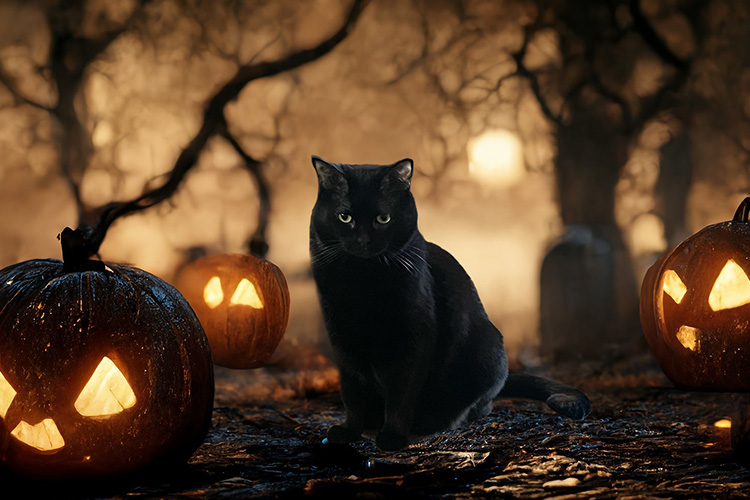
A jack-o’-lantern and black cat may remind us of Halloween, but why is that? photo by Erica Simone and Tara Vinlove (special thanks to Brady's cat Hibiscus for posing for this shot)
Halloween is a time of fun and frightening traditions whose origins can be traced back hundreds of years.
Spooky season is upon us once again and so it is time for black cats, jack-o’-lanterns, and trick-or-treating. To many, these traditions are familiar since childhood and bring many joy and a good fright, myself included. However, when you think about it, these traditions are a bit strange (scooping out pumpkin guts and carving a face???), which begs the question: where did they come from?
To begin, Halloween itself comes from the 2,000 year old Celtic festival called Samhain, which celebrated the new year and the beginning of the winter season. It was believed that during this time, the veil between the land of the living and the dead was thinner, so spirits came back to visit their homes. People lit bonfires and carved frightening faces in vegetables to ward off the dead and wore disguises like witches and goblins to avoid being recognized by evil spirits. The holiday evolved when the Catholic Church wanted to suppress pagan holidays in Europe by creating All Saints’ Day to celebrate saints and martyrs on November 1st and All Souls’ Day to remember all dead Catholics. The day before All Saints’ Day was known as All Hallow’s Eve, and by the middle ages, the holidays of Samhain, All Saints’ Day, and All Souls’ day merged to the secular holiday of Halloween due to their similarities regarding the dead. Irish immigrants brought the holiday and many of its customs to the United States in the 1840s.
One popular Halloween activity, carving jack-o’-lanterns, started with the Samhain festival when people would carve out root vegetables to frighten away spirits. Later, the Irish folktale of Stingy Jack told the story of a man who tricked the devil and was thus denied entry into heaven or hell after he died. He was forced to wander the world as a ghost with only a carved out turnip with a coal to light his way. From this legend and the ancient tradition, Irish people in the 18th century began to carve spooky faces out of turnips and light them lit up with candles to frighten away evil spirits. When the tradition moved to the U.S. with Irish immigrants, turnips shifted to pumpkins as they are native to North America and perfect for carving.
Another common Halloween tradition, dressing up in costumes, stems from Samhain as people dressed in scary disguises to avoid being caught by spirits. This pagan tradition influenced the Christian holiday of All Souls’ Day as people lit bonfires and wore elaborate costumes to celebrate in Europe. Like other traditions, this came to America when the Irish immigrated. In the early 20th century, Halloween costumes remained terrifying get-ups to avoid spirits, but in the 1930s and 40s, pop culture began influencing costume choices and the holiday became more lighthearted.
For children, trick-or-treating is a fun custom with roots in the festival of Samhain. The Celtic people would put out food to please the wandering spirits and people dressed as spirits would sometimes partake in this food, similar to how costumed children can get candy. Christianity reached the tradition when poor children and adults would go to the homes of wealthier people on All Souls’ day and promise to pray for the dead in exchange for small cakes. In the U.S. in the 1920s and 30s, the trick part of trick or treating was more common as people used the night to vandalize and cause mischief. To prevent this, communities instituted trick or treating which only grew stronger with the rise of the suburbs after WWII.
One common symbol of Halloween, black cats, can be traced to the middle ages when black cats were a symbol of the devil and many people accused of witchcraft had pets, especially black cats. The colors of Halloween, black and orange, can be traced back to the Celts as black represented the death of summer while orange represented the harvest in autumn. So this Halloween, when you don a frightening costume or carve a pumpkin, remember that you may be surrounded by the ghosts of people hundreds of years ago who did the same thing.